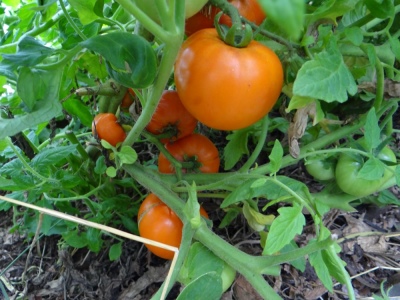
- Authors: Khovrin A.N., Maksimov S.V., Tereshonkova T.A., Kostenko A.N., Agrofirma POISK LLC
- Year of approval: 2015
- Category: grade
- Growth type: indeterminate
- Appointment: fresh consumption
- Ripening period: mid-season
- Ripening time, days: 115-120
- Growing conditions: for film greenhouses
- Bush size: tall
- Bush height, cm: 200
Honey dew is a tomato with an unusual color and amazing taste. You should definitely try to grow it in a greenhouse, since the variety has good resistance to some diseases, which makes it easier to care for it.
Description of the variety
Tomato Honey dew belongs to varietal plants of the indeterminate type. Grown in greenhouses.
The bushes reach a height of 2 meters. The honeydew tomato has a medium branchiness. Its fruits are suitable for fresh consumption.
The main qualities of the fruit
When ripe, orange fruits, when not yet ripe, are light green in color. Large in size, weighing up to 450 grams. They have a slight ribbing, flat-round shape.
Tomatoes with honeydew have a fleshy, but at the same time dense pink flesh.
Taste characteristics
The sweet, sugary taste distinguishes the fruits of this variety.
Ripening and fruiting
The described variety is mid-season. After 120 days, you can start picking ripe fruits. The Medovs had long-term fruiting, fruits begin to be harvested in July and finish only by the end of August.
Yield
The yield indicator for the variety is 6.9 kg / sq. m, thus, it belongs to high-yielding plants.
The timing of planting seedlings and planting in the ground
Seeds are sown in March; young bushes can be planted in greenhouse soil already in May.

Growing tomato seedlings is an extremely important process, because it largely depends on whether the gardener will be able to harvest at all. All aspects must be taken into account, from seedbed preparation to planting in the ground.
Landing scheme
With the Honey Dew variety, a planting scheme of 40x60 cm is used.

Growing and care
Tomato requires compulsory shaping. It is allowed to leave up to 2 stems. Plants must be tied to stakes or trellises.
Seeds are sown to a depth of 3-4 cm. Simultaneously with sowing, 50 kg / ha of granulated superphosphate are introduced into the rows.
Timely loosening of the soil is of great importance in growing tomatoes Honey dew, especially after watering, with the threat of soil crust formation.
Caring for honeydew includes watering, loosening, airing, protection from diseases.
To reduce the dropping of flowers, as well as to accelerate the growth and ripening of fruits, it is advisable to treat the first 2-3 brushes with a growth stimulator of 2,4-DN. More effective in this regard is spraying plants with "Dexter" at the beginning of fruit ripening. Tomatoes Honeydew at the same time ripen 10-12 days earlier.
Growing tomatoes of this variety requires constant watering without waterlogging the soil, which can damage the plant, causing root rot. Seedlings need water in small doses, but often during the period of fruit ripening, the amount of water is increased.In the period from full germination to the beginning of fruit formation, soil moisture is maintained at 70%. For this sowing of tomato honeydew is watered twice. For the formation of the crop, from the moment of fruit formation until the beginning of their ripening, the soil moisture in the 0-0.5 m layer is maintained at 80%, and by the end of the growing season 70%.
At the beginning of budding, the plants are fed with ammonium nitrate (120-150 kg / ha) with simultaneous loosening of the row spacing to a depth of 8-10 cm. During the mass formation of fruits, foliar dressing is carried out with copper sulfate (230-260 g / ha). Good results are obtained by feeding with granular superphosphate (120-150 kg / ha) during mass flowering.
Further care for the honeydew tomato is in the timely fight against diseases and pests.




A plant needs different micronutrients at each stage of growth. All fertilizers can be divided into two groups: mineral and organic. Folk remedies are often used: iodine, yeast, bird droppings, eggshells.
It is important to observe the rate and period of feeding. This also applies to folk remedies and organic fertilizers.
Disease and pest resistance
Agrotechnical pest and disease control measures include proper placement of tomatoes in the crop rotation, weed control and spatial isolation from potato sowing. Timeliness of the procedure is a prerequisite for the successful fight against the use of chemicals. The first spraying against diseases is carried out 12-15 days after the emergence of full shoots, the second - 10-12 days after the first.
The honeydew tomato has resistance to the tobacco mosaic virus; the bushes should be treated from other pathogens from the moment the seedlings are planted. Bordeaux liquid or copper sulphate is used, and commercial fungicides have worked well.
To protect plants from late blight, 5-7 days before planting seedlings under film shelters, they are treated with 0.3% Cineba solution. For spraying, a suspension of "Tsineb" (0.5%), copper oxychloride (0.4%), "Kuprozan" (0.5%) are also used.
Treatments with Bordeaux liquid are completed 7-9 days, with other preparations 20 days before the start of fruit collection. To combat the Colorado potato beetle, the insecticide "Volaton" (0.2-0.3%) is added to the fungicide solution. The flow rate of the working fluid is 500-600 l / ha. Good results are obtained by using the preparations "Tsimbush" (0.5 kg / ha) and "Zolon" (2 kg / ha).
Insecticides or proven folk remedies are saved from the invasion of insects.



























































































